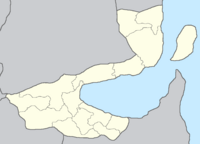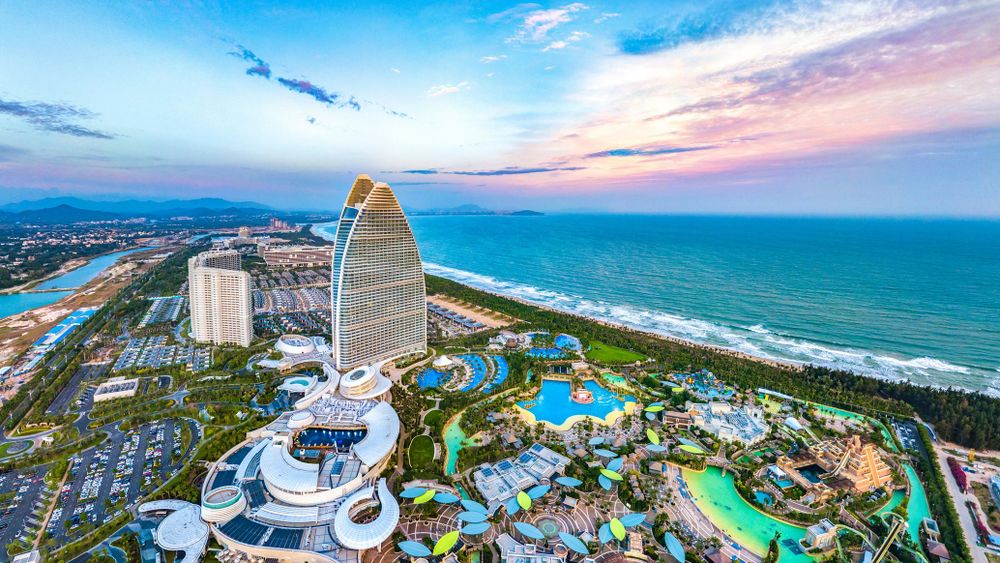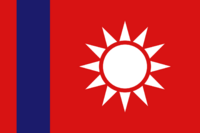Waiping
Waiping 外坪市 Wàipíng shì | |
|---|---|
City | |
Clockwise from top: Waiping skyline, Waiping South Resort, Samha Buddhist Temple | |
Map of Monsilva with Waiping highlighted | |
| Country | |
| State | |
| Settled | 11th century BCE |
| Declared city | 5 June 1436 |
| Bazhong state est. | 3 June 1983 |
| Government | |
| • Body | Waiping City Council |
| • Mayor | Meng Ye (Waiping Party) |
| Population (July 2022) | |
| • Total | 1,445,989 |
| Time zone | AMT+13 (Monsilvan Eastern Time, MET) |
| ISO 3166 code | MS-BAZ-W |
| Major airports | Waiping City Airport (WPY) |
| Transit System(s) | MRA Waiping Tram |
| Police[1] | Waiping Metropolitan Police |
| Ambulance[2] | Bazhong State Ambulance |
| Fire[3] | Bazhong Fire Service |
Waiping (Monsilvan: 外坪市; pinyin: Wàipíng shì), is a city in Monsilva and the capital of the state of Bazhong. It is located on the state's eastern coast along the Bay of Monsilva. Bazhong is famous for its flat coastline which hosts many public beaches and seaside resorts. As the capital of Bazhong, it is the seat of the Bazhong State Government, and is home to the Bazhong State Office. The city has an estimated population of 1,445,989 (July 2022). Waiping is Monsilva's 10th most-populous city, placing it ahead of Sanzhong but behind Chishang. The city holds 63% of the state of Bazhong's population, with the other 37% living in the cities of Menggu or Houzhuang or in the many towns scattered across the state.
Despite being much smaller than many of Monsilva's most famous cities, Waiping is a very popular tourist destination. This is thanks to its wide sandy beaches and plentiful supply of five and four star seaside resorts. It also claims to be a quieter alternative for many of Monsilva's bigger cities, while still providing the 'Monsilvan experience'. The area in which Waiping is located has been inhabited for thousands of years, with some of Monsilva's earliest settlements being located in and around where Waiping is in today. The earliest evidence of a settlement resembling Waiping can be dated back to the 8th century BCE, while the first mention of the city is from the 6th century BCE which described Waiping as the capital of the Xin dynasty, one of Monsilva's earliest dynasties. Before the 20th century, most of Bazhong, including Waiping, focused on agriculture, with farms filling up the outskirts of the city which remained predominantly commercial and residential throughout most of its history. However, in recent history, Waiping has relied heavily on the tourist industry as its main source of income.
Being a popular tourist destination, Waiping has many attractions to offer. These attractions can include: Waiping South Resort, Samha Buddhist Temple, Waiping Museum of Marine Biology and Aquarium and the Yin Family Ancestral Park. Due to the city's coastal location and popularity, cruise line companies such as S-Line have established their headquarters in the city. Education in Waiping is good, with many educational institutions in the city. The Bazhong State University, located in Waiping, is a fairly well regarded university which is most popular for its marine biology and other oceanic studies. The city is served by railways, highways, an airport and bus lines which allow travellers to enter and exit the city. The city is extremely well-served thanks to its central location in the country; high-speed railway services allow travellers to reach cities such as Amking, Shangrao, Zhangye, Maojie, Menchi and Luhai. Waiping City Airport has most of its traffic during holiday season, however it ranked as the 11th busiest airport in Monsilva in 2022.
Contents
Toponymy
The name, Waiping comes directly from the HY Pinyin of the Monsilvan "外坪", (Wàipíng). The character "外" (wài) means "outside" or "outskirts", the original meaning is thought to be referring to the city's location on the coast. Meanwhile the character "坪" (píng) means "flat field", likely referring to the city's very flat nature.
History
Early history and dynastic eras
Waiping has been inhabited since long before Monsilva's first dynasties. Most of what is now Waiping was farming land for the majority of the city's history, even during periods when it had many people, the city was always surrounded by farms and pastures. Waiping first gathered importance in Monsilva's history during the Xin dynasty in which Waiping served as the capital. The city also witnessed Monsilva's earliest confirmed war, the First Invasion of the Xin dynasty in 540 BCE by the Former Yuan dynasty, which initially attempted to annex the dynasty alongside the Xia dynasty, however disagreements between the two dynasties lead to only a small portion of the Xin dynasty being given to Yuan, while the rest stayed independent.
The war is the reason that Waiping now has many remmenants of fortifications which would have surrounded the city during the dynasty. However, during and after the Second Invasion of the Xin dynasty in 230 BCE, many of the city's fortifications were destroyed. There was some restoration done during the Zhou dynasty (1201-1568), however only small portions remain today. During the economic turmoil in the Zhou dynasty during the 16th century, Waiping suffered greatly from starvation, despite the regions large abundance of crop fields, successive bad summers and winters during the 1540s and 50s meant that food was scarce in the city for a very long time.
Empire and Civil War period
When the Zhou dynasty ceded itself to the Empire of Baltanla in 1568, the economic crisis came to an end and Waiping was able to recover. During the Empire, Waiping served as a frequent port for sea travellers and merchants who wished to land away from larger cities such as Amking or Zhangye. This developed Waiping's markets and commercial industry and allowed the city to expand in population and size. However, its smaller size compared to the other nearby cities meant that its growth was hindered by more and more travellers going via the other cities simply for convenience and cheaper prices.
During the Empire, Waiping received what some call the earliest form of 'tourism', whereby foreign diplomats who would be communicating with the colonial government located in Amking, would stay in specially built hotels where they could stay overnight after travelling on long journeys by ship but feared the dangers of Amking's busy ports, so they had landed in Waiping instead. This became a more popular option after the Kingdom of Great Shan was formed after it gained independence from the Empire of Baltanla in 1730.
When the Monsilvan Civil War hit in 1824, Waiping was right in the middle of the conflict. The Battle of Waiping was the war's bloodiest battle which resulted in the death of many soldiers and civillians on both sides. As well as people being killed, many animals were killed by the Imperial Armed Forces which lead to a huge drop in animal product supplies which affected many civilians and ironically affected the Imperial forces more than the Liberate Monsilva Movement, who had been the intended target.
Post-civil war and modern Monsilva
Once the Kingdom of Monsilva was established at the end of the war in 1830, Waiping had been seriously damaged, with the majority of its buildings and structures having been completely or partially destroyed. However this allowed the city to be completely rebuilt for a new purpose away from its previous history of agriculture. The city decided to head for luxury, with many mansions and palaces being built for the royal family and other members of Monsilvan nobility. As the 20th century came around and the concept of modern tourism began growing, Waiping was one of the first cities to begin focusing on accomodating tourists and other travellers through resorts and hotels.
During martial law in Monsilva, Waiping suffered from the regimes restrictions on tourism and travel, which prevented many foreign tourists from visiting the resorts which lead to some closing down permanently. Unlike many cities in Monsilva, the general populous of the city were not particularly violent in their opposition to the government during the protests of the early 1970s. Many resort workers and owners made subtle many subtle protests against the government which usually resulted in almost nothing. However, during the 1978 Monsilvan protests, the protests in Waiping became more promenant and actual demonstrations took place in the city. Due to other cities being much more troublesome, there were very few military police on duty in the city, and it did not take long for members of the Monsilvan Revolutionary Army to overpower them and occupy the local government.
When the Monsilvan Republic was being federalized in the early 1980s shortly after its establishment, Waiping was already serving as the capital of Bazhong, and therefore was made the seat of the new Bazhong State Government in June 1983.
Government
Local government
Waiping has its own city council, the head of which is the Mayor of Waiping. The city council serves as a replacement for the county councils which would exist for the counties that make up the city if Waiping was not a multiple-county city. The council is currently lead by the Waiping Party.
State government
Waiping, as the capital of Bazhong, is home to the Bazhong State Government in the State Office. The Bazhong State Parliament, also in the State Office, is a 50-seat unicameral legislature which serves the entire state of Bazhong, including the city. The seats correspond to each municipality of the state, some of which are Waiping's urban municipalities.
Geography
Waiping is located on Bazhong's eastern coast along wide, sandy beaches. The city is very flat, with a background of Bazhong's western mountain range. Due to its flat nature, on a clear day, it is possible to see both Zhangye across the water, and Houzhuang down the coastline. Constrasting east Waiping's tourist-oriented style, west Waiping is very residential and gradually transitions from suburbs into farmland and pastures for crops and animals. Waiping has very warm summers and mild winters, with temperatures usually peaking at 35 degrees Celsius in the summer and sinking to 10 degrees Celsius in the winter.
The city's coastal location unfortunately brings many tropical storms and occasional typhoons during the wet seasons. However, the city is extremely well prepared for these events, with all buildings having many mandatory requirements including reinforced windows and roofs. These measures, although mostly praised, have often been criticized for being the main reason behind the city's expensive house prices.
Cityscape
Demography
As of 2022, there are over 1.4 million people living within Waiping's metropolitan area, making it Monsilva's tenth-largest city by population, placing itself ahead of Sanzhong but behind Tsingyi. Waiping is a very diverse city, with the population having multiple significant minorities residing within it. The city also has quite an older population, likely due to high living expenses and few entry-level workplaces driving away many younger people. The city is densely packed in its eastern tourist districts, however its suburbs are much more spread out, with Waiping having more gated communities than any other city in the country.
Residents of Waiping are predominantly followers of Monsilvan folk religion or Buddhism. However, there is also a noticeable following of religions that aren't native to regions close to Monsilva, including Christianity and Islam, mostly among the non-Monsilvan residents of the city.
Education
Waiping has many educational institutions around the city, from elementary schools to universities. The city is home to the Bazhong State University, which is well-known for its top-ranking marine biology course and other courses relating to the study of the oceans and the life within them. According to federal law, education in Waiping is mandatory up to the age of 16. The state government has attempted multiple times to raise the mandatory age to 18 alongside many other states in Monsilva, however as of 2023, all of these attempts have failed.
Culture
Sport
The most popular sport in Waiping is yuchio. Waiping is famous for being the birthplace of the sport and still holds the headquarters of the Global Federation of Yuchio since its foundation in 1908. Yuchio is culturally important in Waiping, and the city features multiple statues and other monuments dedicated to the sport and some of its most popular players.
Another popular sport in Waiping is volleyball, more specifically beach volleyball. The city is home to the Monsilva national volleyball team and is the only host city of the BVL, Monsilva's only volleyball league. The sport is very unique to Bazhong, as most of the rest of the country do not play the sport as often. This has made the sport an important part of Bazhong and Waiping culture.
Football is also a popular sport in the city, with Waiping City F.C. being its most popular professional team.
Tourism
Waiping is home to many tourist attractions which include:
- Waiping South Resort
- Samha Buddhist Temple
- Waiping Museum of Marine Biology and Aquarium
- Yin Family Ancestral Park
Travel
Waiping is served by the Waiping Tram system within the city, but is also served extremely well nationally by the Monsilvan Railways Administration which operates both commuter and high-speed rail to cities such as Amking, Zhangye, Maojie, Menchi, Luhai and Shangrao. The city is also home to Waiping City Airport, which is Monsilva's 11th busiest airport (2022). The airport mostly runs flights during the holiday seasons, with out-of-season flights usually only being domestic.
See also
| Rank | State | Pop. | Rank | State | Pop. | ||||
|---|---|---|---|---|---|---|---|---|---|
 Amking  Luhai |
1 | Amking | Amking | 10,855,226 | 11 | Sanzhong | Weishi | 1,116,871 |  San Kong  Menchi |
| 2 | Luhai | Luhai | 5,050,800 | 12 | Haimao | Leibo | 1,042,225 | ||
| 3 | San Kong | Shaoyu | 4,066,512 | 13 | Yinjiang | Shaoyu | 984,717 | ||
| 4 | Menchi | Meixian | 3,973,229 | 14 | Huiyong | Shaoyu | 826,314 | ||
| 5 | Maojie | Maguan | 3,461,317 | 15 | Tsingyi | Luhai | 800,179 | ||
| 6 | Shangrao | Donguan | 2,953,057 | 16 | Baoan | Zaixian | 795,974 | ||
| 7 | Zhangye | Xiaogu | 2,585,883 | 17 | Taimali | Xishanjia | 776,469 | ||
| 8 | Wodai | Wuzhong | 2,245,521 | 18 | Dali | Wuzhong | 596,911 | ||
| 9 | Chishang | Huachang | 1,674,966 | 19 | Menggu | Bazhong | 584,320 | ||
| 10 | Waiping | Bazhong | 1,445,989 | 20 | Taoyuan | Meixian | 558,627 | ||






